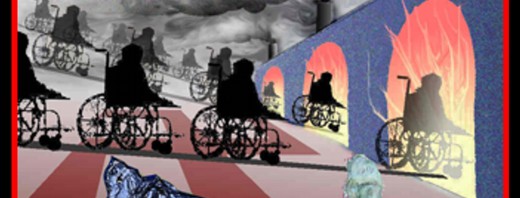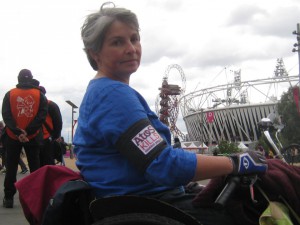
Get the Tories OUT – NOW!
Black Triangle supporter Karl Winnett WRITES:
Some of you may have heard of Author and playwrite Nabil Shaban.
This book is about how disabled people were treated in Nazi Germany; this really makes terrifying reading and not just for disabled people but for all the people of Britain.
This is an echo from history that seems to be alive and thriving in the modern British Conservative party, very disturbing indeed 🙁
|
“THE FIRST TO GO” with the author’s article Disability and the Performing Arts ISBN 978-0-9548294-1-4 size: 197mm x 126mm
|
||||
|
|
||||
| REVIEWS | ||||
|
Linda Rogers |
||||
| – – – – – – – – – – – – – – – – – – – – – – – – – – – – – – – – – – – – – – – – – – – – – – – – – – – – – – – – – – – – – – – – – – – – – – – – – – – – – – – – – – – – | ||||
|
Mary Specht |
||||
| – – – – – – – – – – – – – – – – – – – – – – – – – – – – – – – – – – – – – – – – – – – – – – – – – – – – – – – – – – – – – – – – – – – – – – – – – – – – – – – – – – – – | ||||
|
Steeped in the potent themes of eugenics and social discrimination, ‘The First To Go’ is a haunting piece of theatre which spotlights the Disabled Holocaust: one aspect of a much wider and more diverse killing field that, according to the author’s introduction, is largely overshadowed by its Jewish counterpart. Told through the eyes of disabled and non-disabled characters, Nabil Shaban weaves a tale which moves from contemporary Berlin to the Aryan ideals of Nazi Germany and an assassination attempt on Adolf Hitler. Throughout the course of this shrewdly built narrative, Shaban compels the reader to face the uncomfortable reality of a human society in which designer babies could well be the thin end of a wedge which might yet see history repeating itself… The first scene sets the tone in dramatic fashion by portraying a chilling present day case of hypnotic regression. In this state of mental playback George, a man confined to a wheelchair and who is seemingly reliving the ambitions of Adolf Hitler, pronounces the looming spectre of a biocractic state, and its accompanying onslaught against the disabled community. The ironic nature of George’s regressed identity is very much of a piece with Shaban’s writing style, which demands the reader’s complete and undivided attention, and a fair degree of critical thinking to boot. In short, there is no mental exit for the lazy reader. Following this highly evocative opening the play builds upon its already considerable momentum by moving directly on to its centrepiece. Here, a group of institutionalised disabled German citizens, and their medical attendants, gradually confront the machinery of Nazi Germany’s looming euthanasia programme. In switching from present to past, Shaban makes important associations between Nazi Germany’s Disabled Holocaust and today’s climate of physical perfection – a state of affairs which Shaban terms ‘Body Fascism’. As events continue apace there is presented another, equally well-drawn backdrop, in the form of the July 20 Plot of 1944. This real-life episode is delivered in a finely judged manner, focusing as it does on the motives and justifications of the plotters themselves. In choosing to portray the events surrounding this attempted coup, Shaban examines the moral reasoning of those individuals who resort to violence as their final answer. Just such a terrible conclusion is evidenced, albeit in a strikingly open-ended fashion, in the last actions of George, a man who has more than just the shadow of the past on his mind. Within these meticulously assembled scenes there are portrayed, as Shaban himself calls them, disabled heroes: the nurse Brunhilde, the philosopher Siegfried and Hitler’s would-be assassin Claus von Stauffenberg. In contrast, Shaban keeps his scales finely balanced by inserting a particularly notorious disabled villain: Josef Goebbels, Minister for Public Enlightenment and Propaganda.
Shaban is careful, however, not to paint a caricature of Goebbels. Instead, there is drawn a character who reasons and analyses his way through circumstances around him, thus portraying an even more shocking individual in the process. Authenticity is a common trait of the other characters that appear in the course of the story. Heide, one of Siegfried’s disabled friends, is a case in point.
Heide is not the only example. Helmut, a man with Downs Syndrome, makes what is perhaps the most damning point of all, when he observes that: “We don’t wear badges. We don’t need to. Our bodies are our badges.” (Act I, Scene IV) Helmut’s remark upon the social discrimination branded on to his body, and the bodies of his friends, is a high point amongst many other well written lines, demonstrating Shaban’s shrewd use of dialogue to do his moral talking for him. The love which develops between Siegfried and Brunhilde is another point of characterisation worth noting. Their growing bond becomes arguably the greatest weapon against the ideology which strives to wipe out any traces of disability – or should that be difference? – from the face of the Third Reich. And, moreover, it is Brunhilde who digs up what residual humanity there is in the characters of Eva, another of the medical attendants, and who joins the story telling circle formed by Siegfried and his friends, thereby recognising their humanity in the process. A further dimension found in Shaban’s writing is his shrewd choice of moral and social issues, which help to fine tune his narrative and trigger the reader’s interrogation of the text. One clear example is found in the story telling circle of Siegfried, Heide and Helmut which enables these three – and later Brunhilde – to forge their own community: a community which acts as a buttress against the relentless social corrosives applied to them each day by some of their attendants. Medical practitioners such as Dr. Spottegeburt and Dr. Brandt echo the hollow rhetoric of the eugenics lobby, cosmetically hiding their appalling notions behind a gleaming façade of clinical precision and sterile words. In these brilliantly formed characters there is revealed the type of human being who can degrade and socially butcher his or her fellows in much the same way as one might conduct a discourse on the importance of good footwear. The calculating inhumanity of this pair is no figment of Shaban’s imagination, but it is to the author’s credit that they do not become exaggerated grotesques, but rather, like Goebbels, remain authentic and, as a result, stamp an even colder and more frightening shape upon the reader’s consciousness. Assembling this multilayered tale, which seamlessly moves between the past and the present is no little challenge. Shaban’s effort is an outstanding example which deftly traces the terrible contours of the Disabled Holocaust through events both contemporary to it as well as those somewhat closer to the here and now, and which undoubtedly rest within its considerable shadow. …Incredibly, ‘The First To Go’ is no gargantuan epic and its two acts may be digested at a single sitting.
However, its weighty subject matter and rich dialogue deserve a far more protracted – and considered – consumption. In addressing the Disabled Holocaust and its victims – labelled by the Nazis as ‘Useless Eaters’ – Shaban helps to publicise a tragedy which is in serious need of contemporary scrutiny. And, bearing in mind the understandable anxieties of the disabled citizen who lives in a world in which genetic screening and the legally – as well as socially – acceptable abortion of disabled foetuses is a growing trend, it is little wonder that the fear that the dark matter of 1930s and 1940s Europe should rise to the surface once more is more than a little justified. Jez Strickley for The Ethical Spectacle |
||||
| – – – – – – – – – – – – – – – – – – – – – – – – – – – – – – – – – – – – – – – – – – – – – – – – – – – – – – – – – – – – – – – – – – – – – – – – – – – – – – – – – – – – | ||||
|
‘The First To Go’, a new play by Nabil Shaban, could it seems, at a mere first glance, be easily categorised for the sake of reviewing purposes: It is a historical play. It charts the rise of Nazism. It foreshadows Hitler’s genocide of the Jews. Ahh, the Holocaust, yes of course – now we know what territory we are in, the diabolical treatment of the Jews, surely? These are events we are all familiar with. Therefore, it must be safe to assume, that we have another defiant, yet heart-rending cry from those dark chapters in history on our hands then? Well, yes, but wait, before we go on . . . who said I was referring to the Jews and their Holocaust?
At last, together we can acknowledge the truth, we can acknowledge the brutality – we owe that much to the people who senselessly lost their lives, don’t we? At least, we as the audience can give some ceremony to these events.
One might say that this new play certainly carries a fair old amount of responsibility on its shoulders. Shaban is straightforward and non-apologetic about his objectives for the play.
Ultimately, though it is the play itself that speaks to me. Let us not forget that Shaban has given us more than mouth-pieces for despair and rage in the fully-rounded characters of Brunhilde, Siegfried, Helmut and Heide. By telling stories they weave towards their own dreadful and inevitable fate. It is at these times when the play is at its most engaging and poignant, as their story swings from being a hopeful thriller to being painfully heartfelt. It depends whose turn it is to tell the tale. They are Shaban’s valiant, courageous and romantic heroes of the ‘Disabled Holocaust’. Robyn Hunt Robyn Hunt who has Cerebral Palsy, is a professional actor, writer and drama workshop leader. |
||||
| – – – – – – – – – – – – – – – – – – – – – – – – – – – – – – – – – – – – – – – – – – – – – – – – – – – – – – – – – – – – – – – – – – – – – – – – – – – – – – – – – – – – | ||||
|
These questions from ‘The First to Go’ are very important questions all members of the audience – disabled & non-disabled alike – need to ask themselves. For the non-disabled audience members this can be especially challenging because this play flies very justly in the face of all the stereotypes holding every one of us hostage to this day.
Before the curtain rises on this story, one might be mislead by the ingrained stereotype that all the victims are disabled & all the heroes & villains are non-disabled. That disabled must equal weak & helpless, & non-disabled must equal courageous & strong. But from the very beginning of the story it’s easy realize that, just as in real life, there are no simple stereotypical lines drawn. The victims are disabled, but Helmut, Heidi &, especially, Siegfried are just as heroic as Brunhilde & Claus von Stauffenberg, both of whom joined the ranks of the disabled during the war. To me, Siegfried is the bravest, strongest & most heroic of them all – never giving up in the face of a life full of odds that would leave most of us cowering in a corner waiting to die. Yet he fights with everything he has to the bitter end & asks for no pity in return – only the love & respect he so richly deserves. There are non-disabled heroes in the book, as well. The author does not forget those who joined the fight against the Nazi’s once they finally realized what was truly happening.
The villains are also a mix of disabled & non-disabled.
So caught up in his own desire to be accepted as non-disabled that he seems unaware that, should the Euthanasia program flourish, he is sealing his own fate as well.
As a non-disabled reader it might be very easy to try & emotionally distance oneself from the details of the past atrocities. To think it could never happen to you. But keep in mind the questions above. Keep in mind the other very important facts that the author brings to the forefront of this story. The Euthanasia program did not start with the Nazi party & it did not end there. A program like this, whether it’s called a Euthanasia program or Human Genome Research or Eugenics, can only end with the total annihilation of humankind. These programs, designed to ‘cure’ the human race of disabilities, will not stop once there is no one left who meets the current criteria. The Body Fascists criteria insists that there must always be someone at the bottom of the pecking order to hate, loath, make fun of &, eventually, rid the world of. Whose next? And whose next after that?
 Nazi Poster – translation: 60,000 Reich marks. What this person suffering from is hereditary defects costs the People’s community during his lifetime. Comrade, that is your money too. When will it be YOUR turn to go?
Are you going to wait until the authorities tell you that you must hand over your child to be institutionalized or killed because he or she might be a pollutant to the gene pool? In a world where fetus testing for disabilities is becoming mandatory, Wrongful Life lawsuits are becoming more & more commonplace & plastic surgeries are glorified throughout television, are you so sure it won’t happen? How to stop this continuing discrimination & destruction is a choice left up to each & every one of us. Is taking a life for a life the only solution left open to us? Would killing those heading up the current programs end the problem or make it worse? Is there another way? After spending my life surrounded by non-disabled people who deal with life’s adversities through hate & violence- mainly aimed at me – , I must tell you that the author, Nabil Shaban, has become one of my heroes along with his friend, the late David Rappaport. In the face of seemingly overwhelming odds he has remained indomitable, incorrigible, strong, courageous, yet also kind, loving & generous. And he puts up with me, which should earn him instant sainthood right there. It takes a lot of courage & strength to put so much of his heart & soul into this play & everything he does. He had to overcome the odds of a life time of body fascist brainwashing to even write this play himself. That brainwashing is something I also deal with everyday, so I understand the daily struggle all too well. I will always be grateful to him for allowing me to volunteer my time, energy & money to bring this play & all of his work to the attention of the American public. This is not something I chose to do out of pity or charity, but rather because I wanted to be a part of the solution – his solution. Jessica Markoff Chaney http://www.oocities.org/sirius_book_works/SBW_1st2go.html See also: T-4 Aktion Website |
||||




4 Responses
Nazi Persecution of the Disabled: Murder of “The Unfit”
http://www.ushmm.org/museum/exhibit/focus/disabilities/
Euthenasia Program
http://www.ushmm.org/wlc/en/article.php?ModuleId=10005200
Utilizing a practice developed for the child “euthanasia” program, T4 planners began in the autumn of 1939 to distribute carefully formulated questionnaires to all public health officials, public and private hospitals, mental institutions, and nursing homes for the chronically ill and aged. The limited space and wording on the forms, as well as the instructions in the accompanying cover letter, combined to convey the impression that the survey was intended to gather statistical data.
The form’s sinister purpose was suggested only by the emphasis which the questionnaire placed upon the patient’s capacity to work and by the categories of patients which the inquiry required health authorities to identify…
Secretly recruited “medical experts,” …worked in teams of three to evaluate the forms. On the basis of their decisions beginning in January 1940, T4 functionaries began to remove patients selected for the “euthanasia” program … to transport them by bus or by rail to one of the central gassing installations for killing…
The “Euthanasia” Program continued until the last days of World War II, expanding to include an ever wider range of victims, including geriatric patients, bombing victims, and foreign forced laborers…
but its true its happening now and thats the sad part that the rest dont see ,whots happening to us daily lossing some on the way every week they go for whot so that they can say they got their monies back whilst we lose our lives yes they are a very greedy bunch jeff3
The trouble is peoples self esteem is already being worn away due too the hate campaign conducted by the media, which is a cruel and abusive thing to do but being done by our toxic government.
http://www.netdoctor.co.uk/interactive/gallery/main.php?g2_itemId=1075&g2_tab_id=
Euthanasia and Eugenics are Both National Socialist Regime EVILS
There are so many Simularities between National Socialist Regime Germany and
Con Dem Rich Peoples Government United Kingdom with Regards to the
Victimisation of the Poor and Vulnerable
People Must Get their Heads Out of Themselves and Bloody Wake Up